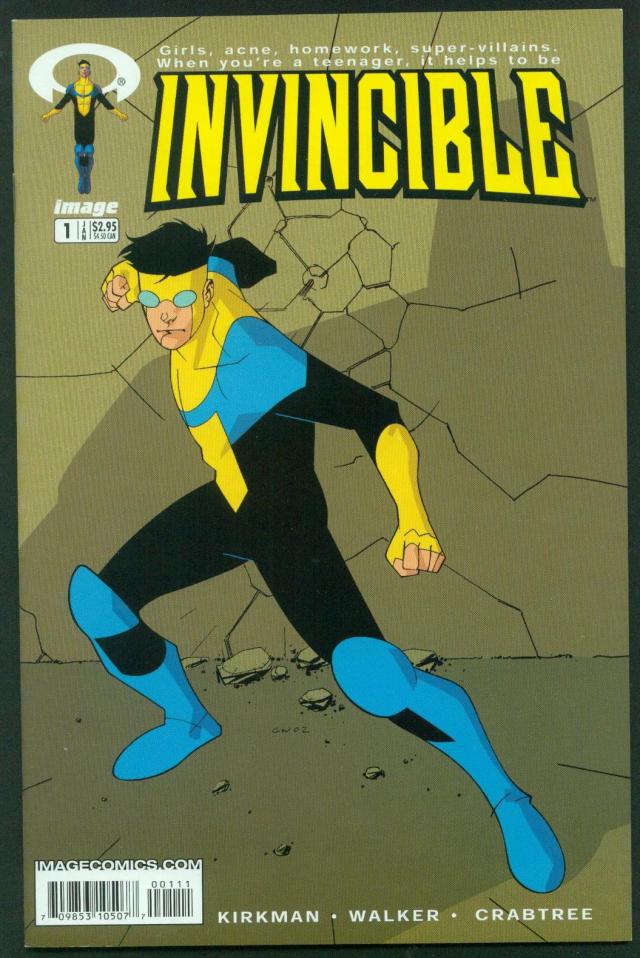
God, I hope this crumbling wall doesn’t fall on me. That would make me look so foolish.
Trying to do something different with the form of the superhero comic is, more often than not, a losing battle. Most people who try to reinvent this wheel think that the way to go is hyper violence and “mature” content. For an example of that type of storytelling look at the entirety of Image Comics 1992 output. Ah 1992, Clinton was about to begin his first term and all our successful superheroes had numerous pouches, futuristic guns and no feet. What a time it was to be alive. Little did we know back then that it would take an Image comic to truly do something different in the superhero genre. It just took Image 11 years to actually get to that point. It is Image, so expect everything to be late. (Shoutout to the nerds that actually get that joke.)
In 2003 when the first issue of Invincible hit the stands the comic book industry was just starting to recover from the damage brought on by the speculator market which, coincidentally, is something Image Comics really fostered. This is the world that Robert Kirkman and Cory Walker birthed Invincible into, a world recovering from the ravages of Chromium and Lenticular covers. The only way this book was able to succeed is because it took things back to basics. In terms of story construction, the first six issues of this book followed the classic Marvel comics blueprint storytelling really closely. It’s a really simple equation: superhero discovers he has powers, he is excited about these powers, bad guys happen, while these bad guys are happening the hero’s civilian life goes on and he must learn to balance the two parts of his life. See, simple.
The actual plot of Invincible is very domestic. Mark Grayson, our titular character, is a normal seventeen-year-old attending Reginald VelJohnson High School, the greatest fictional high school in history of fictional high schools. It just so happens that Mark’s father, Nolan Grayson, is a humanoid alien superhero with a power set not dissimilar to that one dude from Metropolis. Nolan Grayson’s Omni-Man has superspeed, superstrength, enhanced senses etc. He’s your pretty standard superhero bruiser. Mark has the same powers. By issue three, Invincible is already part of a team and has a possible romantic interest in Atom Eve. The brisk plotting makes the reader want to read more and more because the action scenes are dynamic, the high school stuff is funny and, in general, the characters are extremely compelling. Robert Kirkman is really good at conveying a comedic tone that makes this book feel light and fun. His trademark repeated panel pause where he repeats the same exact panel three or four times are great pieces of visual humor. The dialog layout leads to a lot of single speech bubble single panel punchlines, usually delivered by Mark’s mom Debbie. This is something you don’t see in many independent or even mainstream comics, most of which tend to go the dour serious route like Kirkman’s other book, the smash hit The Walking Dead, so the humor is a nice change of pace.
I want to talk about Corey Walker’s art for a second. Walker’s simple character designs along with Bill Crabtree’s bold coloring make this book feel like a four color ink book from the 60s or 70s. The backgrounds are mostly one solid color during fight scenes so as not to distract you from the actions of the characters in the panel. Pleasing art makes any book more readable, at least for me.
The first volume of Invincible works within the coloring book lines of superhero tropes, and that’s fine. Sometimes you just need to read a comic-book-ass comic book. As the story goes on however, as you will see over the course of the series of articles that I will do about this book, you’ll see something that Marvel and DC superhero books don’t have… true growth and change. This is the element that propels Invincible to greatness.